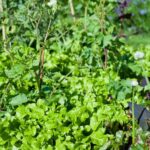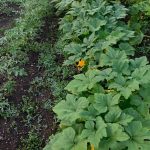Vegetable gardens provide a great opportunity to grow fresh, organic produce right in our own backyard. However, ensuring the health and well-being of our plants requires more than just regular watering and fertilizing. One crucial aspect of gardening that often goes overlooked is the need for proper covering.
Covering for vegetable gardens serves many purposes and offers numerous benefits. Firstly, it provides protection from unfavorable weather conditions such as extreme heat, frost, or heavy rain that could damage or even kill delicate plants. Additionally, covers act as a barrier against pests and animals that may be tempted to nibble on your carefully cultivated veggies.
There are several types of coverings available for vegetable gardens, each offering its own unique advantages. Organic mulch, such as straw or grass clippings, not only helps to retain moisture in the soil but also adds nutrients as it breaks down over time. Plastic covers can create a microclimate ideal for certain crops while also acting as a protective shield against pests and weeds.
Row covers come in two main varieties – floating row covers and hoop covers – both of which offer protection from frost and pests while allowing sunlight and water to reach the plants. Shade cloth provides relief from excessive sunlight, preventing sunburn on delicate leaves while still allowing air circulation. Netting and mesh covers keep unwanted visitors at bay without obstructing airflow or sunlight.
By understanding the different types of covering options available, gardeners can select the ones most suitable for their specific needs and preferences. From protecting against inclement weather to warding off pests, choosing the right coverings can help ensure a successful harvest from our vegetable gardens year-round.
In the following sections, we will explore each type of covering in more detail, highlighting their benefits and potential drawbacks so you can make an informed decision about how best to protect your beloved garden.
Organic Mulch
Organic mulch is a popular and effective option for covering vegetable gardens. It involves using natural materials such as straw, grass clippings, or leaves to protect the soil and plants. Organic mulch offers numerous benefits that can improve the health and productivity of vegetable gardens.
Improved Soil Health
One of the main advantages of using organic mulch in vegetable gardens is its ability to improve soil health. As the mulch breaks down over time, it adds organic matter to the soil, which enhances its fertility and structure. The decomposing mulch also releases essential nutrients into the soil, making them available for plant uptake. In addition, organic mulch helps retain moisture in the soil by reducing evaporation and preventing weeds from competing with garden plants for water.
Weed Suppression
Another benefit of organic mulch is its ability to suppress weed growth in vegetable gardens. By providing a layer of coverage over the soil surface, organic mulch prevents sunlight from reaching weed seeds, inhibiting their germination and growth. This reduces the need for manual weeding or the use of chemical herbicides in vegetable gardens.
Temperature Regulation
Organic mulch acts as an insulator for vegetable gardens by regulating soil temperature. During hot summer months, it helps keep the soil cool by providing shade and preventing heat buildup. In colder seasons, organic mulch acts as a protective barrier against freezing temperatures, reducing frost damage to sensitive plants. This temperature regulation can extend the growing season for certain vegetables and ensure their healthy growth.
In summary, organic mulch offers several advantages when used as a covering option for vegetable gardens. It enriches the soil with nutrients, suppresses weed growth without harmful chemicals, and regulates temperature to create optimal growing conditions for plants. Gardeners looking for sustainable and environmentally friendly options will find organic mulches like straw, grass clippings, or leaves to be an excellent choice for covering their vegetable gardens.
Plastic Covers
Plastic covers are a popular choice for covering vegetable gardens due to their affordability, availability, and ease of use. One of the main advantages of using plastic sheeting as a cover is its ability to retain heat.
By creating a greenhouse-like effect, plastic covers can help to maintain higher temperatures during cooler months, extending the growing season for vegetables. This is especially beneficial for gardeners in colder climates who want to start planting earlier in the spring or grow vegetables later into the fall.
Another advantage of plastic covers is their ability to protect plants from heavy rainfall. Plastic sheets create a barrier that prevents excessive moisture from reaching the soil, which can help prevent root rot and other water-related issues. Additionally, plastic covers can also act as a physical barrier against pests such as rabbits and squirrels.
However, there are some disadvantages to using plastic sheeting as a covering option for vegetable gardens. One major drawback is its lack of breathability. Plastic covers restrict airflow and can lead to excessive humidity inside the garden bed, which promotes the growth of fungal diseases such as powdery mildew. In addition, if not properly secured or placed under tension, strong winds can cause the plastic sheets to tear or become dislodged.
Furthermore, while plastic covers offer protection from rain and pests, they do not allow natural watering or rainfall infiltration into the soil. This means that gardeners must rely on manual irrigation methods such as drip systems or hand-watering. Overhead watering may damage or dislodge the plastic sheets, reducing their effectiveness as a cover.
In summary, plastic sheeting offers several advantages such as heat retention and pest protection but also comes with drawbacks including limited breathability and potential tearing or displacement in windy conditions. Gardeners should weigh these pros and cons when considering plastic covers for their vegetable gardens.
| Advantages of Plastic Covers | Disadvantages of Plastic Covers |
|---|---|
| – Retains heat and extends the growing season | – Lack of breathability and increased humidity |
| – Protects plants from heavy rainfall | – Possibility of tearing or displacement in windy conditions |
| – Acts as a barrier against pests | – Limited watering options and reliance on manual irrigation |
Row Covers
Row covers are an effective way to protect plants in vegetable gardens from harsh weather conditions, pests, and frost. They are versatile and can be used throughout the growing season. Row covers create a physical barrier that shields plants from cold temperatures, insect damage, and extreme weather events such as heavy rain or hail.
One type of row cover is the floating row cover. These covers are made from lightweight fabric that allows air, water, and sunlight to permeate through while protecting plants from frost and pests. Floating row covers can be laid directly over crops or supported by hoops to provide extra space for taller plants. They are easy to install and remove, making it convenient for gardeners to work with.
Another type of row cover is the hoop cover. Hoop covers consist of semicircular hoops made from wire or PVC pipe that form a structure over the plants. The hoops are then covered with fabric or plastic sheeting to create a protective enclosure. Hoop covers offer additional benefits such as increased insulation and protection against larger pests like rabbits and deer.
When using row covers, it is essential to consider the specific needs of your garden. Some factors to consider include the desired level of protection, climate conditions in your region, and the types of pests you want to repel. Additionally, it is crucial to monitor temperature fluctuations inside the row covers during periods of extreme heat or cold. Adequate ventilation should also be provided to prevent overheating or excess moisture buildup.
In summary, row covers are valuable tools for vegetable gardeners as they offer protection against frost, pests, and extreme weather conditions. Floating row covers allow for ample air circulation while safeguarding plants from frost and insects. Hoop covers provide superior insulation properties along with protection from larger animals. By selecting the appropriate type of row cover based on your specific needs, you can ensure healthier plants and a more successful harvest in your vegetable garden.
Shade Cloth
Shade cloth is a popular option for providing protection from excessive sunlight, heat, and preventing sunburn on delicate plants in vegetable gardens. It is a lightweight fabric that allows for some light penetration while reducing the intensity of direct sunlight. Shade cloth comes in various densities, which determine the amount of shade it provides.
Benefits of Shade Cloth
Using shade cloth in vegetable gardens offers several benefits. Firstly, it helps to regulate temperature by reducing heat build-up and providing a cooler environment for plants. This can be particularly advantageous in regions with hot climates or during periods of intense heatwaves.
Secondly, shade cloth protects plants from excessive sunlight exposure. Some vegetables, such as lettuce and spinach, are more sensitive to direct sunlight and can easily suffer from sunburn if not adequately protected. By creating a shading effect, shade cloth helps to prevent damage caused by solar radiation.
Lastly, shade cloth also offers protection against pests and animals. In addition to providing shade, it acts as a physical barrier to keep insects and birds away from your crops without obstructing airflow or limiting access to pollinators.
Choosing and Using Shade Cloth
When selecting shade cloth for your vegetable garden, consider the density or percentage rating indicated by the manufacturer. A 30% density is generally suitable for most vegetable crops as it provides enough shade without excessively limiting light absorption needed for photosynthesis. For more heat-sensitive plants or during periods of extreme heat, you may opt for higher density covers up to 50%.
To effectively use shade cloth in your garden, ensure it is properly installed over your crops. The cover should be securely anchored to prevent it from shifting or being blown away by wind gusts. It should be suspended above the plants using stakes or hoops at an appropriate height to allow room for plant growth while still offering sufficient protection.
Regular monitoring of the garden’s microclimate is essential when using shade cloth. Observe how plants respond to the shade provided and make adjustments accordingly. It may be necessary to temporarily remove or adjust the cloth on cooler, cloudy days to allow more light to reach the crops.
Netting and Mesh
Netting and mesh covers are valuable tools for any vegetable gardener looking to protect their crops from pests, birds, and small animals while still allowing for adequate airflow and sunlight. These covers act as a physical barrier between the plants and potential intruders, preventing them from snacking on your hard-earned produce. Here are some key benefits and considerations when using netting and mesh covers in your vegetable garden.
One of the primary advantages of using netting or mesh covers is that they keep pests such as insects, rabbits, squirrels, and deer at bay. The fine openings in the netting prevent these creatures from reaching your vegetables, saving you from potential crop loss.
Additionally, netting also serves as a barrier against birds that may be tempted to feast on your ripening fruits or peck at tender seedlings. By creating this protective layer over your garden beds, you can ensure that your crops remain safe from damage caused by unwanted visitors.
While providing protection against pests and animals, netting and mesh covers still allow airflow and sunlight to reach your plants. Adequate airflow is crucial for preventing fungal diseases or mold growth that can result from poor air circulation. By using netting with larger holes or a mesh cover with a lighter density, you can ensure that fresh air circulates freely among the plants in your vegetable garden.
When choosing netting or mesh covers for your vegetable garden, it’s important to consider the material used. Opt for durable materials like nylon or polypropylene that offer long-lasting protection against pests. Ensure that the size of the openings in the netting is small enough to prevent entry by common pests but large enough to allow necessary pollinators like bees to access your flowers.
Cold Frames
Cold frames are a valuable type of covering for vegetable gardens that offer several benefits including the extension of the growing season and insulation for plants. A cold frame is essentially a low-lying structure with transparent walls and a sloped roof that allows sunlight to enter and provide warmth while trapping heat inside.
These structures can be built using a variety of materials, including wood, brick, or cinder blocks, and they can be covered with materials such as glass, polycarbonate, or polyethylene.
The main advantage of cold frames is their ability to extend the growing season by creating a microclimate that is warmer than the outside environment. By capturing and retaining heat from sunlight during the day, cold frames help to protect plants from frost and provide them with additional warmth they need to thrive during cooler seasons. This allows gardeners to start planting earlier in the spring and continue cultivating crops later into the fall or even winter in some regions.
In addition to extending the growing season, cold frames also provide insulation for plants. The walls and roof of a cold frame act as barriers against wind and temperature fluctuations, helping to maintain a more stable and favorable environment for plant growth. This insulation can be particularly useful in regions where temperatures dip below freezing or fluctuate dramatically throughout the day. Cold frames also offer protection from heavy rainstorms or hail, preventing damage to delicate plants.
A properly constructed cold frame should have a sturdy base that is levelled and secure. The walls should be angled to maximize sunlight exposure while still providing sufficient height for plant growth. The roof should be sloped so that it captures maximum sunlight during the shorter days of winter. Glass or transparent plastic canopies are commonly used as coverings for cold frames due to their ability to let in ample sunlight while retaining heat.
Using a cold frame requires careful monitoring of temperature and ventilation to prevent overheating on sunny days or excessive cooling at night. It’s important to open or close the lid on the cold frame accordingly to maintain an optimal and stable environment for plant growth.
Overall, cold frames are an excellent option for gardeners who want to maximize their vegetable production by extending the growing season and protecting plants from harsh weather conditions. With proper construction and management, cold frames can be a valuable addition to any vegetable garden, enabling year-round cultivation and improving yields.
Greenhouse Covers
Greenhouse covers are a popular option for vegetable gardens as they offer several advantages. One of the main benefits of using greenhouse covers is that they allow for year-round cultivation. By creating a controlled environment, greenhouse covers extend the growing season and enable gardeners to grow vegetables even during colder months or in regions with shorter growing seasons. This is particularly beneficial for those who rely on their gardens for a fresh supply of produce throughout the year.
Another advantage of greenhouse covers is their ability to provide protection from harsh outside conditions. Greenhouse covers create a barrier against extreme weather events such as heavy rain, strong winds, or hailstorms. They also offer insulation, helping to maintain a stable temperature inside the greenhouse and protect plants from sudden temperature fluctuations that can be damaging.
In addition to protecting plants from adverse weather conditions, greenhouse covers also shield them from pests and diseases. The enclosed space of a greenhouse makes it more difficult for pests like insects or animals to access the plants, reducing the risk of damage or infestation. It also provides some level of protection against airborne diseases and fungal infections that can spread through wind or rain.
When choosing a greenhouse cover, there are different options available such as glass, polycarbonate sheets, or polyethylene film. Glass provides excellent light transmission but is heavier and more expensive. Polycarbonate sheets are durable and offer good insulation properties while still allowing sufficient light penetration. Polyethylene film is lightweight and inexpensive but may need replacing after a few years due to wear and tear.
Overall, greenhouse covers offer significant advantages for vegetable gardens by enabling year-round cultivation and providing protection from harsh outside conditions. The choice of materials will depend on factors such as budget, desired lifespan, and specific needs of the plants being grown. Gardeners should carefully consider these factors when selecting a greenhouse cover to ensure optimal growth and success in their vegetable gardens.
Floating Row Covers
Floating row covers are an effective and versatile option for protecting vegetable gardens from various environmental factors. These lightweight covers are made from a thin, breathable fabric that allows light, air, and water to penetrate while offering protection to the plants underneath. One of the main advantages of floating row covers is their ability to shield plants from frost damage. By covering the crops with these sheets, gardeners can extend the growing season by several weeks or even months.
In addition to frost protection, floating row covers also serve as a barrier against pests. The fabric used in these covers is typically small enough to prevent insects like aphids and flea beetles from reaching the plants. This not only helps in preventing damage caused by chewing insects but also reduces the risk of plant diseases transmitted by certain pests.
Another benefit of floating row covers is their lightweight nature. Unlike heavier materials like plastic sheeting, they can be easily laid over plants without causing them any harm or stress. The fabric gently rests on top of the crops while being supported by hoops or stakes for proper structure and support.
It’s important to note that although floating row covers provide excellent protection against frost and pests, they may limit pollination if left on during flowering periods. To ensure adequate pollination for fruit production, it is recommended to remove the covers temporarily or allow bees and other pollinators access to the plants.
Overall, floating row covers are a cost-effective way to protect vegetable gardens while promoting healthy growth and yield. They are easy to use, lightweight, and offer multiple benefits such as frost protection and pest exclusion. Gardeners looking for a sustainable and efficient covering option should consider incorporating floating row covers into their gardening practices.
Conclusion
In conclusion, there are many different types of covering options available for vegetable gardens, each with their own set of advantages and disadvantages. Organic mulch, such as straw, grass clippings, or leaves, provides numerous benefits including water retention, weed suppression, and the addition of nutrients to the soil.
Plastic covers can be a good option for protecting against harsh weather conditions and pests but may lack the ability to allow airflow and moisture penetration. Row covers offer protection from frost and pests, with floating row covers being lightweight and resistant to damage while hoop covers provide extra height for tall plants.
Shade cloth is a useful tool for preventing sunburn on delicate plants and protecting crops from excessive sunlight and heat. Netting and mesh covers can keep pests, birds, and small animals away while still allowing airflow and sunlight through. Cold frames are a great option for extending the growing season by providing insulation and greenhouse covers offer year-round cultivation with protection from outside elements.
When choosing a covering option for your vegetable garden, it is important to consider your specific needs and preferences. Consider factors such as climate, desired level of protection, availability of materials, budget constraints, and aesthetic preferences. By selecting the appropriate covering option for your garden, you can help ensure successful growth and harvest of your vegetables while minimizing potential risks such as pests or extreme weather conditions.
Frequently Asked Questions
What should I cover my vegetable garden with?
When it comes to covering a vegetable garden, there are a few options to consider. One popular choice is using a layer of organic mulch, such as straw or wood chips. Mulch acts as a protective barrier by helping to retain moisture, regulate soil temperature, suppress weed growth, and prevent erosion.
Additionally, it breaks down over time and adds valuable nutrients to the soil. Another option is using floating row covers, which are lightweight fabrics specifically designed for gardening. These covers help shield plants from cold temperatures, pests, and excessive sunlight while still allowing air and water to pass through.
What is the best barrier for a vegetable garden?
The best barrier for a vegetable garden depends on what you intend to protect your plants from. If your primary concern is keeping out pests like birds or small animals, then physical barriers like fences or netting can be effective. Fences made of materials like wire mesh or chicken wire should be tall enough to prevent animals from easily climbing over them or burrowing underneath.
Netting can also serve as a protective barrier by creating a physical barrier around the garden perimeter or individual plant beds. For deterring larger animals like deer, sturdier fencing may be necessary.
What is the best thing to cover your garden with?
When choosing what to cover your garden with, it’s important to consider the specific needs of your plants and the environmental conditions in your area. One option is utilizing plastic sheeting or tarps as a temporary cover during unfavorable weather conditions like heavy rainstorms or frost periods. This helps protect delicate young plants from damage caused by excessive moisture or freezing temperatures.
For longer-term solutions, using materials like row covers made from fabric or plastic can provide ongoing protection against pests, insects, and harsh weather elements while still allowing light and air circulation. Ultimately, choosing the best cover for your garden depends on balancing factors such as climate conditions, desired level of protection needed for your plants, and personal preference.

If you’re looking to get into vegetable gardening, or are just looking for some tips on how to make your current garden better, then you’ve come to the right place! My name is Ethel and I have been gardening for years. In this blog, I’m going to share with you some of my best tips on how to create a successful vegetable garden.





